Thursday afternoon a possible Snowy Owl was reported at Mick Riley Golf Course in Murray, Utah. In the end it turned out to be a spectacular white Gyrfalcon.
After the first inconclusive sighting it wasn’t found again until yesterday afternoon when photos confirmed the bird to be a white Gyrfalcon with falconry paraphernalia attached to its legs. I’ve never before seen this species flying free so I had to go down for a look. I wasn’t disappointed.
When we arrived the bird was perched on a pole at the edge of the golf course. Even with the hubbub from birders, photographers, golfers, dogs and nearby children the falcon was calm and quite approachable.
Soon after I arrived Mike Shaw with HawkWatch International placed a bal chatri trap in an attempt to capture the falcon (the bird is in extreme danger of entanglement with the falconry hardware trailing from its legs). The falcon was very aware of the hamsters inside the trap and flew off several times to investigate. This image and the following four are sequential shots of one of the take-offs. By this time the light was funky and I’m disappointed with the blue cast in the images but didn’t take the time to try to correct it.
When the falcon returned to the same pole after investigating the trap I pre-focused on the pole and was able to get three relatively sharp shots as it landed.
Incoming and …
touch-down.
The Gyrfalcon attracted the attention of several other raptors in the area including a Cooper’s Hawk, Sharp-shinned Hawk, American Kestrel and Merlin. This was the sharpie as it buzzed the falcon.
The falcon investigated the trap several times while I was there. Even though this shot is far from sharp I thought I’d include it because it shows the bird passing over the trap at lower-left. Inside the trap are two hard-working HawkWatch International “staff members” – hamsters named Easy and Breezy. The hamsters are not harmed during the trapping process and live a pampered life.
After I left, Mike Shaw was finally able to capture the Gyrfalcon. It was fed and then spent last night in a mew.
What a drop-dead gorgeous bird this is! I was in awe just to be near it. I also thoroughly enjoyed seeing old friends and meeting new ones as birders and photographers admired this falcon. The entire group was congenial and very respectful of the falcon.
The eventual fate of this falcon is as yet undetermined. It is banded so if the birds handler (I hesitate to say “owner”) can be located it may be returned to the falconer. The band is metal and seamless which indicates that the bird was captive-bred so release into the wild probably isn’t an option. The bird is in its first adult plumage and appears to weigh about 2000 grams. Its halluces and talons have been filed down and its beak needs coping.
I must admit that I’m disturbed by the number of escaped falconry birds I’ve seen (and photographed). In the last four years I’ve documented and posted about a male and a female American Kestrel, a Peregrine Falcon and now this Gyrfalcon – all four escaped from falconers and still had falconry hardware on their legs. And just a few weeks ago an escaped Red-tailed Hawk was found south of here in Lehi, Utah.
I do find that trend unsettling…
Ron
Note: I do hope that any comments on this post don’t degenerate into a bashing of falconers and falconry. I’m aware that the “sport” or practice is controversial and I have some reservations about it myself but I also have much admiration for many falconers because of their absolute love for and devotion to their birds, their incredible knowledge that they share with all of us and the good work many of them do with raptor education.



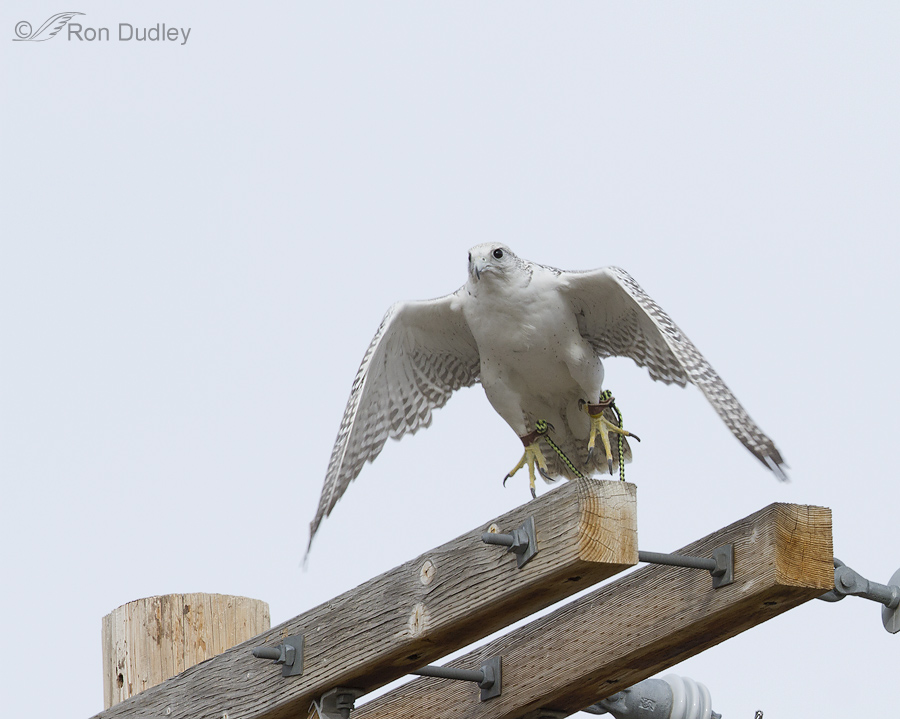
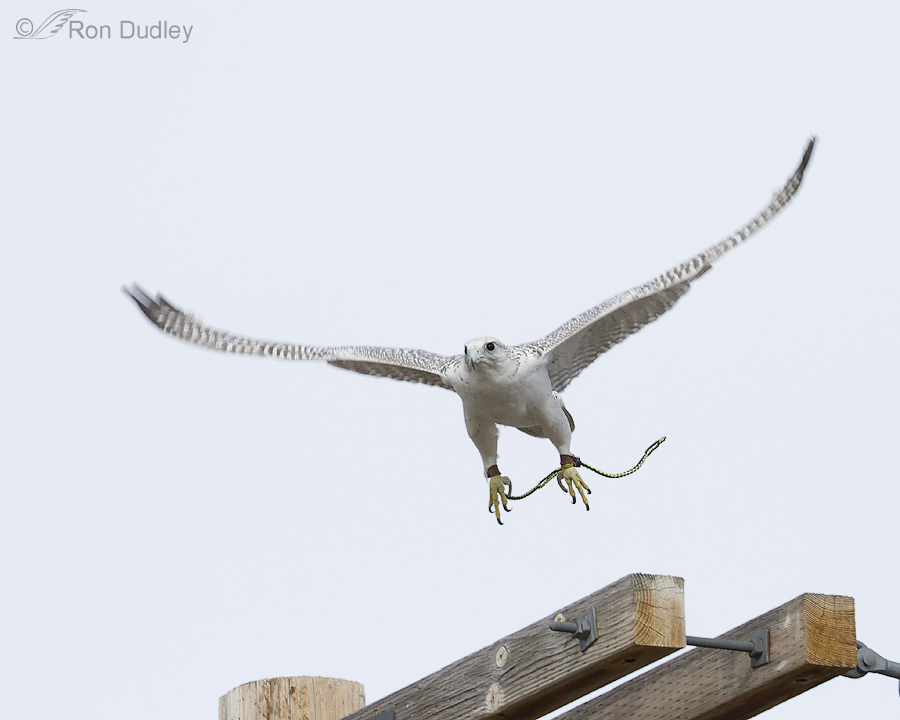
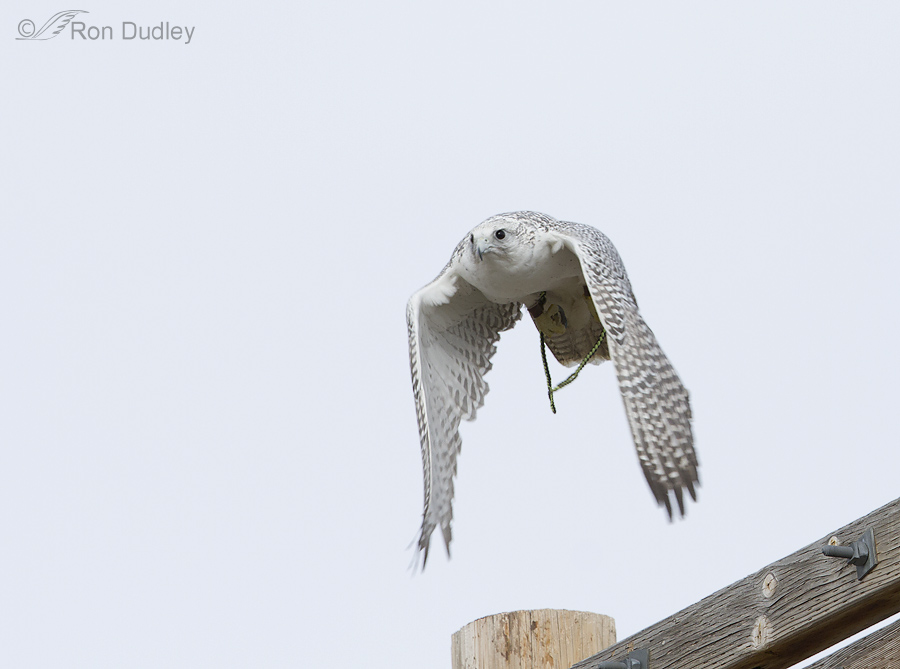
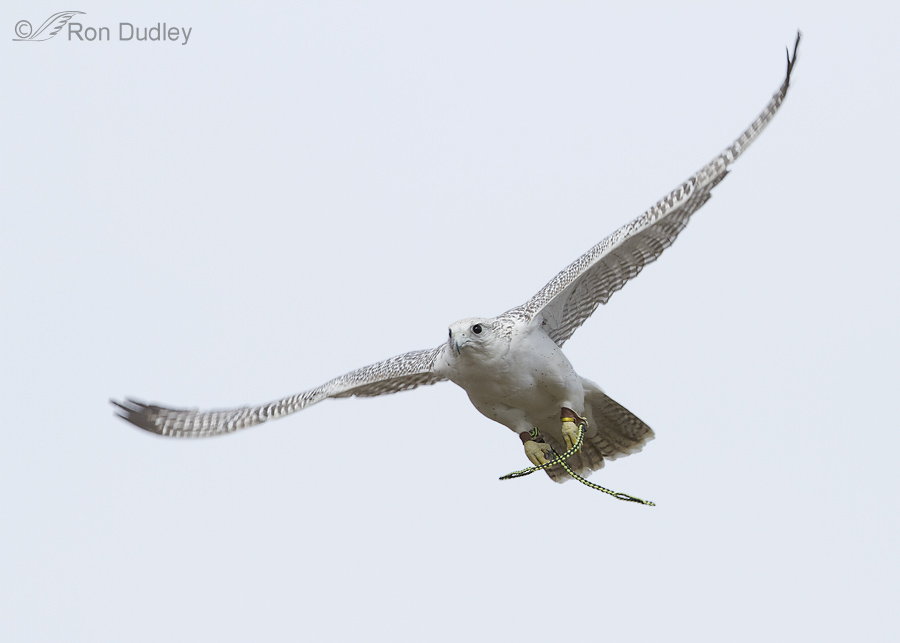
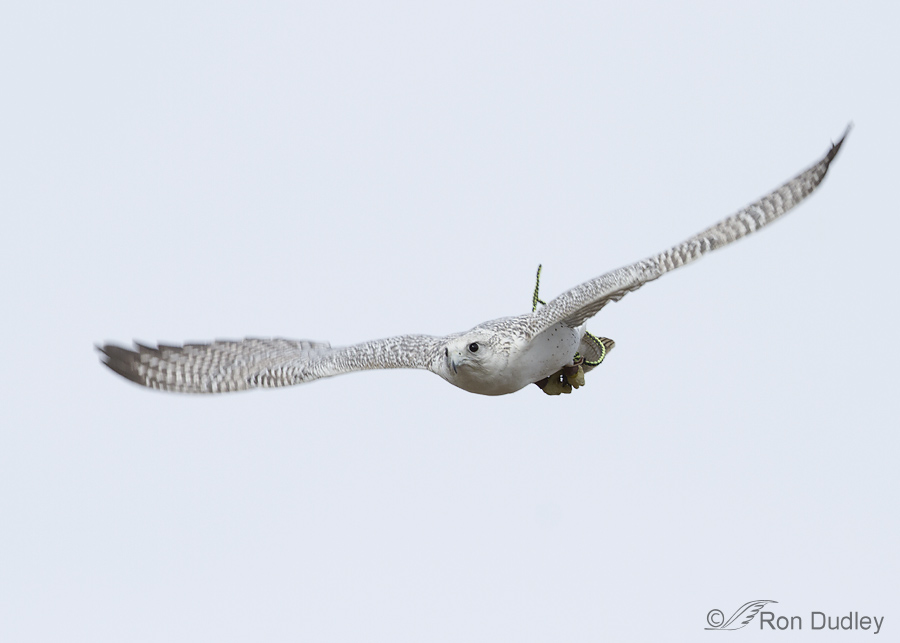
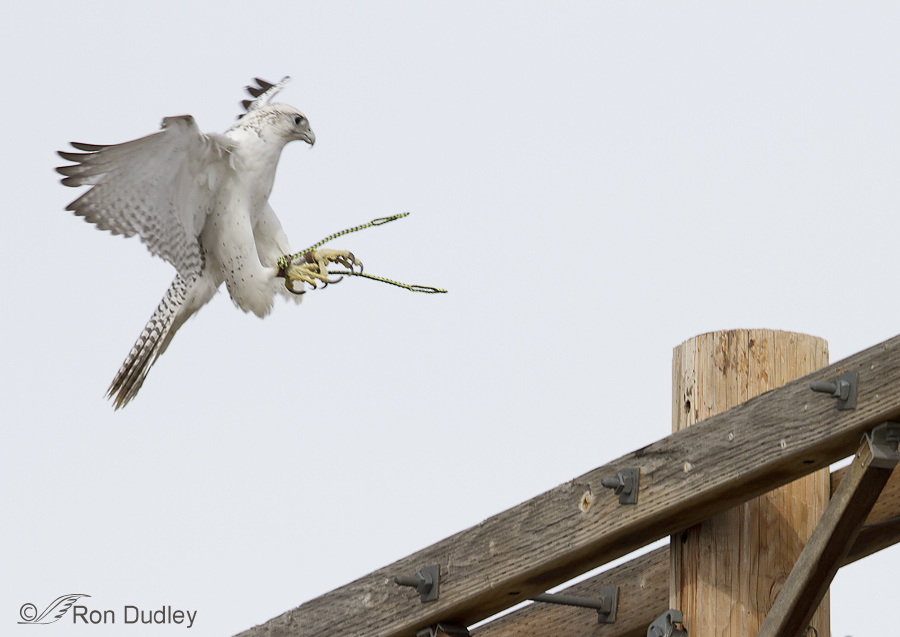
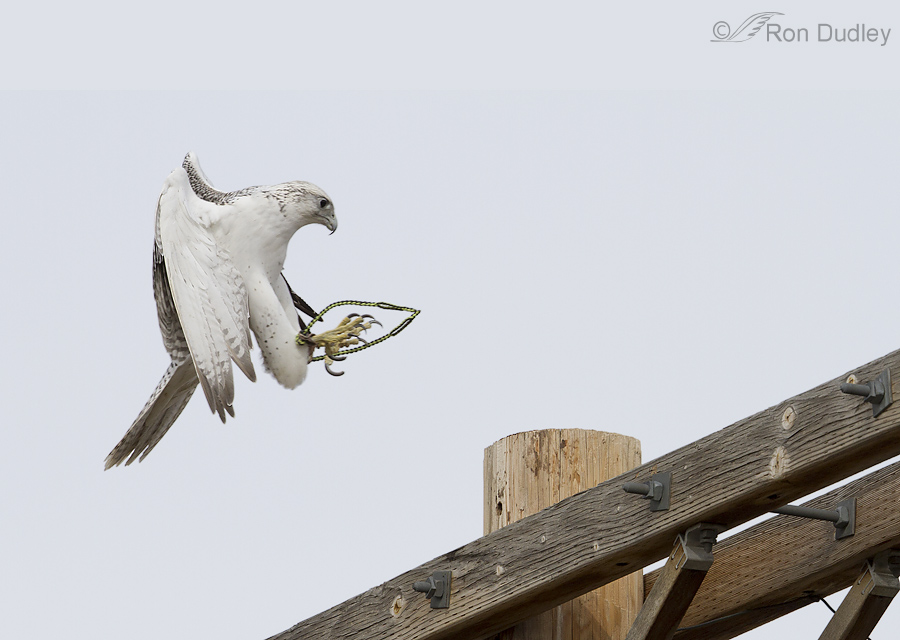
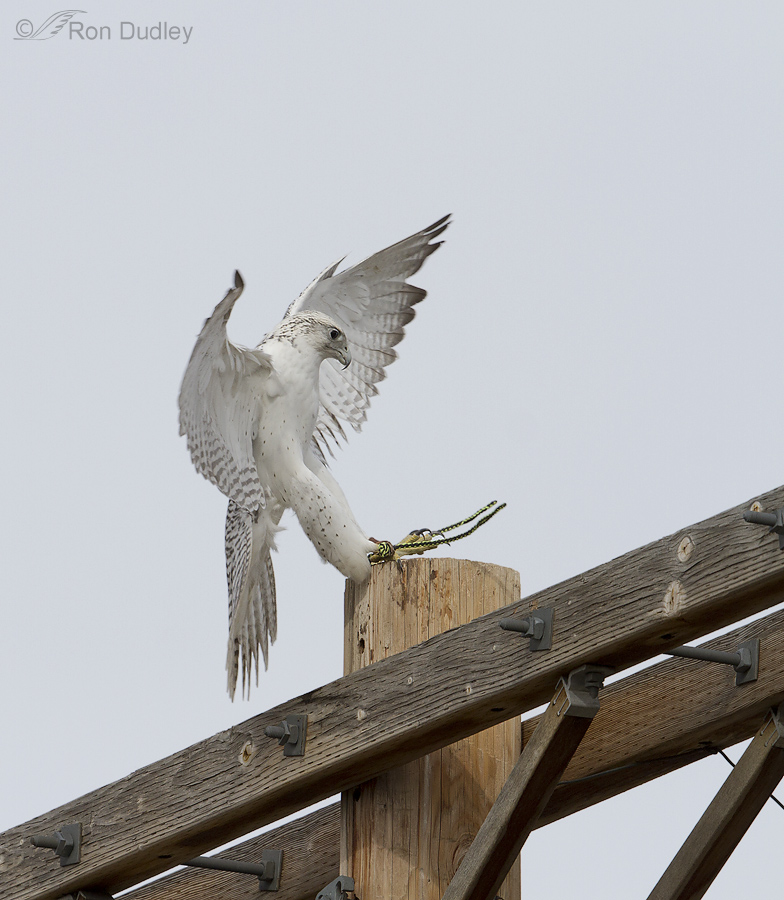
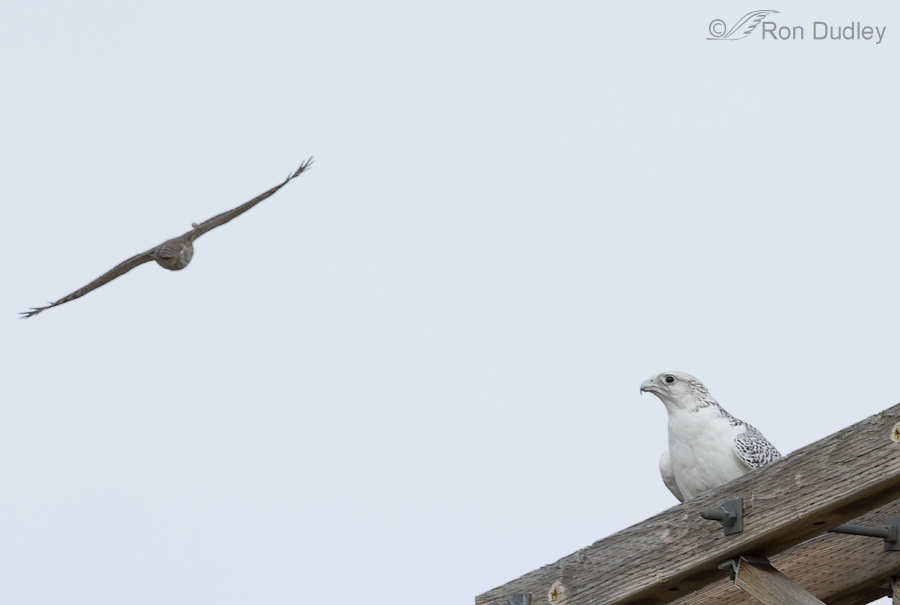
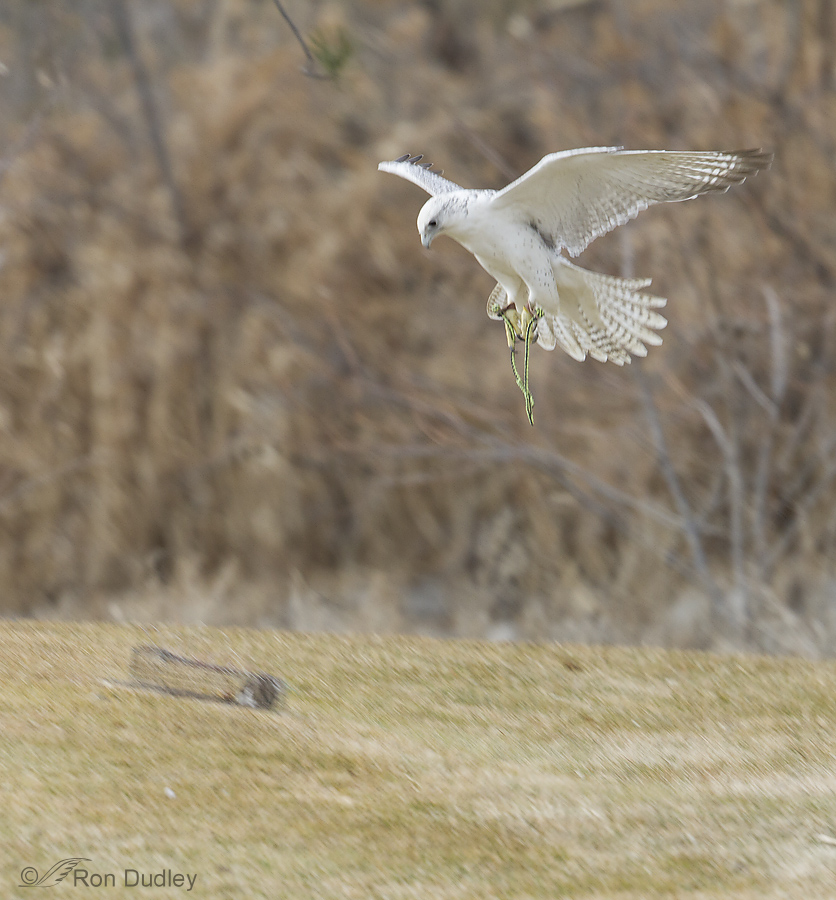
I have lived in Alaska since 1956 (age 11). I got interested in falconry in the late 1950,s and trained and flew my first gyrfalcon in 1961, and have flown mostly “gyrs” my entire life. These activities lead to a life of Raptor adventures, “raptor population surveys,training and hunting
with Alaskan raptors, rehabilitating Alaskan raptors, and participating in the recovery of Alaska’s anatum and tundrius subspecies of peregrine
falcon. In short,to quote an old falconer. “a life runt for sport”.
I give this brief background, to indicate I may have some valid perspective, on this subject.
Your beautiful photographs,show a female white gyrfalcon, with at least, some Alaskan blood, captive bred (seamless band). She is in excellent
feather,her feet look healthy,the talons are fine,excepting the hind talons which are in need of coping.I would expect the bird could catch and
kill without much difficulty. The leather anklets would normally deteriorate in a year or two. The braided nylon or dacron jesses are easily
pulled by the falcon (some birds pull them very quickly, some don’t). The condition of the anklets and jesses look pretty good and might
indicate the bird hasn’t been on the loose a long time. I would have tried a falconry lure, before trying to trap the bird. But if you don’t
know how to approach the bird in a way that tells her you know what you are doing she might get spooky. There are fine falconers in the area
where you are, who likely know who has lost a white gyr in the western U.S. within the last year or two.
A white gyr is a valuable bird. In The U.S. she may have been given to a licensed falconer, she may have been sold by a raptor breeder, to a
falconer for several thousand dollars. I would recommend she be returned to her falconer as soon as possible.
William, you may want to visit my update post on this bird, link in the comment beloow…
For those interested I’ve just posted an update about the eventual fate of this falcon.
https://www.featheredphotography.com/blog/2014/02/28/escaped-white-gyrfalcon-an-update/
This bird is so exquisite, it almost hurts to look at it…it looks like some kind of magical, sacred being..which I think it probably is…Wakan! I keep looking at the series, trying to pick a favorite (a silly waste of time) , but can’t. Each one is wonderful (wish you could zap out the jesses, though)…
Thanks Patty. Yes, “exquisite” describes this beautiful bird well.
I appreciated (and learned from) Ben’s candid and poignant story of his birds. Even those of us (like myself) who have questions about certain practices, recognize the importance of falconry in conservation. The wildlife hospital where I volunteered used falconers to help rehab certain species. The Peregrine recovery program in San Francisco, where I’m from, is facilitated by an amazing falconer who has sacrificed much for the well-being of these wild birds. I suppose the upshot is that all of life is nuanced — and while generalizations are, indeed, unfair, that doesn’t preclude having concerns about viable issues in any field. I think there’s room for it all. The danger is when practices involving human or nonhuman welfare are considered above reproach. Discussion, disagreement and openness are integral to genuine understanding.
“I suppose the upshot is that all of life is nuanced — and while generalizations are, indeed, unfair, that doesn’t preclude having concerns about viable issues in any field. I think there’s room for it all. The danger is when practices involving human or nonhuman welfare are considered above reproach. Discussion, disagreement and openness are integral to genuine understanding.”
Perfectly said, Ingrid. As I’ve said before, you DO have a way with words!
I’d also like to point out that the classification of this as a falconry bird could be incorrect. There are MANY people in the U.S. who breed gyrfalcons and given the equipment etc (very few longwings are flown with *ANY* gear beyond the anklets), it could simply be an escaped breeders bird (stolen, accident etc) and have no affiliation with a falconer (someone who actively hunts their birds).
HawkWatch International supports the many individuals and organizations who work to protect and build awareness around birds of prey, whether they be educators, rehabilitators, or falconers. When we received a call regarding this escaped Gyrfalcon, our first course of action was to contact the Utah Falconers Association to coordinate the rescue and return of this bird. We thank them for their expertise and support. We are currently working with Utah’s Division of Wildlife Resources to find the owner of this bird. Should you have any questions regarding HawkWatch International or our methodologies, please feel free to contact us or view our publications posted on our website: http://www.hawkwatch.org. Thanks to our many supporters who make our work possible, and to Ron for sharing his wonderful photos!
Thanks HWI for all your hard work and all the good you do in general and in this situation. It is greatly appreciated!
Ditto this comment by Ben. HWI rocks!
Another misconception I see almost every year are the sitings of raptors flying around with jesses attached to their legs. It is assumed that these birds belonged to falconers and have escaped. Some of these sitings are reported to our state agency, the Colorado Parks & Wildlife. I have personally seen some of these hawks and found the raptor carrying a snake. From the untrained eye it appears that they are flying around with jesses attached but are actually carrying the prey to a nest or feeding perch.
In response to John: I myself have pulled over thinking I was seeing a Coopers with jesses … but it was pigeon intestines, once I saw her flying again!
And to Jeff: Yes – the bird could be like our gyrfalcons: education birds. And accidents or thefts can happen to any of us. I’ve known both zoos and rehab centers who have lost eagles to theft, for example, as well as falconers. One reason we have two large security dogs and someone living on the property.
And to Ben: I had suggested this bird could be stolen, and no one has stated that falconry is bad; everyone, including me has supported conscientious falconry. I’m so sorry you’ve had those experiences but please reread the comments and I think you’ll realize no one was trying to paint all falconers as bad.
Thanks Louise I appreciate it
Sensational shots of a gorgeous bird !Glad it ended well.
Charlotte
Keep in mind some of these, “escaped”, falconry birds are not escaped at all but STOLEN and released by misinformed individuals who don’t understand what falconry is. It’s important not to jump to conclusions about a bird that is seen in the wild.
My hope in commenting is to share some perspectives that have not been considered. I am aware that an angry tone can come across in typed words. Please know that I am sharing this with a friendly tone and with the hope that those who read can do so with an open mind and with mutual respect.
Before you comment, please be respectful enough to actually read my whole post. I know it is long, but I think it is very applicable.
I am an ethical, practicing falconer, and have been for 27 years. In that time , on 5 separate instances (at 3 different residences)had people break into my facilities and released my birds. This involved jumping over my locked fence, and using bolt cutters to cut through doors that had TWO locks on them. The birds released were captive bred (not from the wild). I am astonished that you all seem to jump to the conclusion that a loose bird with equipment on automatically indicates that a reckless falconer made a mistake. Although falconers do make mistakes, MANY falconers have their facilities broken into and their CAPTIVE BRED birds released illegally. I have yet to notice anyone considering this fact.
There are captive bred horses. Fancy pure bred dogs. Cats. Etc. If I felt that horses were so noble and inspiring that it was an absolute abomination for them to be in a corral, and have people ride them, am I justified in breaking in at night and setting them free? And if I did that, and photographers saw such a horse running free down the street, would they be justified in jumping to the conclusion that the horse was running loose with a bridal on because the horse trainer was a horrible individual who did not take proper care of that horse, even though it was actually running loose due to an illegal break in?
As a falconer I can respect all of your reverence for raptors. But also again astonished at how the value of life can be skewed. You mentioned HWI trapping the gyr falcon with hamsters- something falconers also do. Please know that I support hawk watch and their mission and methods. I even volunteered for them in the late 90’s. But I am shocked that they are praised for trapping with hamsters, while a falconer would be criticized for doing the same thing. I know your issue would be that you would not like the idea of a falconer training a wild trapped bird and that hawk watch releases the birds they typically capture.
But that is not my point. My point is that PETA would place as much value on the hamsters as you do on raptors cared for by falconers. Whether the hamsters were in the possession of a falconer or HWI they would not see it differently.
Again I am glad that HWI recovered the falcon. And I have no issues with their methods. But if you are open to the idea that HWI could have captive bred hamsters that they care for properly in captivity, how could you not be open to the idea of other types of animals being cared for properly in captivity? If you argue that the bird having jesses on is an indicator of abusive treatment, couldn’t it also be argued that putting the hamsters in a cage (bal chatri trap) and letting a falcon attack the cage is ALSO abusive treatment?
I wanted to share one last experience to so you can see what it feels like from a different perspective. In 2004 I had a CAPTIVE BRED female peregrine falcon. I purchased her from a breeder in Nevada. Her captive bred line went back 18 generations. (this means nothing to a falconer, I only share it to point out this is nothing close to a wild bird) I paid the licensed breeder $2,000. I spend $280 to have her shipped with special crates in climate controlled conditions. I hand fed her tiny pieces of meat with tweezers ALL day for months. This food consisted of captive bred frozen japanese quail from a game bird farm. $50 a bad for 20 frozen quail. For a growing baby that added up to a feeding bill of $100 a month.
Now I know many of you curse the notion of “paying” for a raptor or “owning” a raptor. I respect your perspective. But please then respect mine and read the rest, being open to understand the dedication and care that went into this bird (far more that goes into HWI’s hamsters)
I had to take the baby to work to feed her. Every 20 minutes. Have you ever had a puppy, a kitten? a human child? Even if you are furiously against raptors in captivity, surely you can at least respect the bond that comes from raising a life that is totally dependent on you for it’s survival.
When she fledged I trained her to fly totally free. To fly and hunt in Cedar valley and Rush valley. My job allowed me extreme flexibility. I was able to fly her 2-3 times a day. I lived in Midvale. This mean daily drives of 80-100 miles round trip. DO THE MATH! ADD UP THE GAS!!!!! From these flights she was as fit and well muscled as any wild falcon and she flew as free as any as well. She would soar as high as 3,000 feet and dive at over 200 mph. Don’t believe me? I know it for a fact. She had a 3 gram altimeter on that recorded the height. At all times she had her jesses off, and TWO marshall radio transmitters on. These weighed 5 grams each. Roughly the size of 3 raisins. Radio reciever $1200.00 transmitters $275 each
I hope you dont have an ethical problem with flying a trained bird with 2 tiny radio transmitters on, since HWI has put massive GPS transmitters on wild birds. ( a practice that I DONT have a problem with. I only share it to point out how it is comparable)
Flying 3 times a day my falcon flew hunted and chased totally free like a wild bird. And just like a wild bird she narrowly escaped being killed by wild eagles twice and a wild territorial prairie falcon once. I had racked up hundreds and hundreds of hours of feeding, training, flying and driving. Raised a captive bred baby from the age of a fluff ball. Watched her learn how to fly, hunt, dive, and be a free spirit.
She was a fit, well muscled, healthy bird. She was feather perfect in every way. She had blossomed into an incredible spirit.
Then one night, someone climbed my locked fence. The took bolt cutters and cut two Master locks. Broke into her flight pen (mew) and set her free. She had anklets on and er government issued band, but no jesses.
I came out in the morning to find her gone. My heart broke. She had no transmitters on of course, because those are only put on when the bird is flown. I searched for days. I had no way of knowing if she had been stolen or just released by a passionate law breaker determined that “all raptors should be free”. Had someone killed her? Was she stolen and at someones house? Was she flying around my neighborhood or on the other side of the state? I was devastated.
One week later (I found this out after the fact) my falcon was spotted by an old lady. My falcon had killed a seagull in a Walmart parking lot. The lady called the DWR (Division of Wildlife Resources) and reported that “an eagle had killed and was eating our state bird, and when she approached it the eagle wouldnt fly away, and could someone come do something about it” Obviously the lady needed some identification skills.
Officer Mike Roach (Utah DWR conservation officer in the SLC area) arrived at the walmart and approached my bird. As a trained bird, he was easily able to pick her up of the California gull she had killed. He put her in a transport crate, but first noted the band number. He called the DWR office and had them look up the band info, from which he obtained my name phone number and address. But rather than taking the falcon to me, he brought it to a wildlife rehab facility operated by Bill Moore. He gave them my feather perfect, healthy, fat and well muscled falcon and instructed them to “make sure the bird was okay, and then contact me to come pick up the bird”.
But like many of you, the individuals who ran this facility had a deep hatred of falconers. They kept my falcon for a month and NEVER contacted me. Their intention was to keep the bird I had purchased,raised and trained, never contact me, and have the bird transferred to their education permit as I found out later from one of their subpermittees.
But a month later while reviewing reports, officer Mike Roach called me to see if the bird was fine. I had no idea that she had been recovered. He was upset as well, as he had told the rehab facility to contact me. He gave me their number. I called and went over to get my bird back. When I arrived, she was in a 2 foot by 2 foot by 3 foot hand made wooden crate/box. Not a mew, not a flight pen, a box. With no perch. No ability to fly. They said they had been feeding her rats (in falcons which are bird eaters, this weakens their beaks and talons and causes them to crack) ALL of her tail feathers and primary wing feathers were broken from being in the box.
But worst of all, as we approached the box in their back yard, I kept hearing a banging “thump thump thump” as she kept jumping and slamming into the top of the crate in an attempt to get out. I was as polite as I could be. But I was furious inside. I thanked them and took my bird home. I called Officer Roach, and he said that the bird had been in fine healthy condition when he had recovered her from the parking lot.
I took her to Dr. Martin Oar at Creekside animal hospital to have her looked at. She had a cracked beak, broken wing and tail feathers, bumblefoot infection from standing in the crate for a month with no perch, head heathers beaten out from jumping up in the crate, and worst of all x-rays show that her keel was completely fractured from the crate jumping and had punctured a lung. She had to be put down.
so as much as you may hate falconers and say that we are not “suitable long term care” for these noble birds, lets compare. In my care this CAPTIVE BRED falcon, that I spend thousands of dollars and hours to raise, train, and fly had the following:
-Flew free 2-3 times EVERY day except sundays
-flew up to 3000 feet and up to 2 miles out away from me and back… complete freedom
-At home had the security of a double locked flight pen equipped with padded perches, bathpans, open sunlight, etc.
-Was well muscled and fit. Full of energy and life
-Was feather perfect.
-Beak and talons were sharp, grew healthy and had no cracks or problems
-was fed a complete healthy diet of whole quail- comparable to their wild diet.
Then someone breaks in, releases my bird. It ends up in the hands of wildlife rehabilitators that all of you would consider “a suitable long term facility, unlike those horrible falconers” There she received the following:
-Was kept in a 2X2X3 foot wooden box
-NEVER got to fly EVER
-Had no perches. Perched on bare wood
-Fed rodents- a diet completely foreign to a peregrine
-Beak and talons cracked from diet
-Bumblefoot
-Broken tail and wing feathers
-Broken keel from bashing against sides of crate
-Result of these conditions meant the bird had to be put down.
So to sum it up, in my care the bird was flown as free as any wild falcon 3 times a day. She was happy and fit. She was gorgeous and feather perfect in every way. It hurt to hear you say that falconers do not know how to care for their birds, and to hear you claim that everyone else under the sun EXCEPT falconers know what they are doing. Someone as passionately against falconers as many of you, broke and entered a locked facility and set the bird free. WHILE SHE WAS FREE, IF ANY OF YOU HAD PHOTOGRAPHED HER YOU WOULD HAD BEEN UPSET AT THE “HORRIBLE FALCONER” WHO HAD HIS BIRD LOOSE WITH ANKLETS ON when the truth was a very different story. And once she was taken to a “sutable facility” of licensed wildlife rehabilitators, she met a slow painful existence that led to her eventual death. Knowing that with me she flew wild and free thousands of feet in the air, and that then she ended up in a 2x2x3 box for a month sickens me. And the worst part, after all my work and dedication, money time blood sweat and tears to give this falcon a good life, I had to pay $200 to have her euthanized. Not the person who broke in and released my birds, not the DWR officer who didnt bring her to me right away. Not the wildlife rehabbers. I had to.
Please understand that THIS is the type of perspective most falconers are coming from. If you dissagree and think that falconers are all still evil… I respect that and grant you your freedom of opinion. But please be respectful of the fact that there are other perspectives out there.
And to close, again I SUPPORT HWI. I SUPPORT good rehab facilities, and help out extensively with Great Basin Wildlife Rescue. And I also support that all of you are looking out for birds you see that have equipment. I am grateful that you care deeply. Please know that we falconers do too. Even if that is hard for you to believe.
My apologies for the extreme length.
Ben! I am so terribly, terribly sorry about your bird! You are obviously someone who cares very deeply! I learned a lot from your sad, sad story. I can relate because some my own “raises” (no raptors)also had unhappy endings caused by human ignorance, fear, or misguided good intentions…and I know the “slavery” of an every twenty minutes feeding program. I’m glad you used names in your story…positive or negative, they deserved to be known. Thank you for taking the time and effort to write…something that must have made you awfully sad and mad all over again
I remeber seeing a post somewhere about a month and a half ago about a falconer losing his white Gyrfalcon in a very high wind. After looking for it for a few days he found the transmitter in some woods near the lost site. if i recall he was in western Ok or SW Kansas.
I apologize for not responding to the latest comments in a timely manner. My sister is visiting from out of town and I’ve been occupied with other things.
Tomorrow morning DWR will begin efforts to track down the “owner” of this bird. Several folks who have seen this post and have lost white Gyrfalcons (or know others who have) have contacted me. I’ve forwarded your contact information to HWI and assume they (or DWR) will contact you. There has been a lot if interest in this bird – rest assured that every effort will be made to find its owner.
If you contact the region office of the Utah Division of Wildlife Resources and give them the seamless band number they should be able to quickly locate the falconer. They may pass it on to the U.S. Fish and Wildlife Service. Either way it is the quickest way to locate the falconer. I’m sure someone is searching for the bird! As Ron mentioned, this bird could have traveled a long distance but there is a record of the owner and the state or federal agencies will help. And Ron, your photos are great!
I am comforted by comments from Artoxx, Louise and 48dodger about birds being able to remove certain jesses. I wonder how long it takes the bird to figure this out? I am disheartened beyond belief to learn of the price tag and potential outcomes for these birds. There is no limit to human disregard when it comes to other species. That’s precisely why I’m so grateful for organizations like HWI. Thank goodness!
Your photos here of the Gyrfalcon make me realize why there is such a frenzy when a gyrfalcon out here makes it onto a birding list. I’m not a bird/listing chaser, so I rarely follow up on those reports. But now I understand the excitement of seeing this raptor. Your photos make me feel as though I have seen one, they are so pristine. But what a gift to see one in the wild and in flight, as you say.
Lastly, new lens? I’d better catch up! Been out of town and offline for the better part of a month.
Ingrid, Yup – I broke down and bought the new version 2 of the Canon 500mm f/4. Quite a difference from version 1 that I’ve been shooting with for years now.
Accidents happen. Not all, but some are caused by falconer sloppiness. Usually the last thing removed by the falconer is the hood — after telemetry has been attached and jesses removed in preparation for flying. But if the hood was on loose or worked its way loose, the bird could have thrown it, and there’s no telling what can happen then.
There’s a website, falconfinders.com, where people can report lost and found falconry birds. Presently it’s intended for use by California falconers only, but there’s nothing to prevent use by non-Californians.
I have posted this link to the falconry websites.
The bird is wearing what is called ‘mew’ jesses, With no evidence of field equipment or telemetry seems to be on the bird. Falconers use two types of jesses. A ‘mew’ jess with slits for a swivel. Then ‘field’ jesses with tiny or no slits at all. The jesses are of a familiar brand. I am assuming the bird escaped from it’s mews, possibly during a wind storm. To see more about falconry and the equipment used go her: http://www.themodernapprentice.com
There are backpack telemetry units, and the GPS ones are too heavy for many species of raptors at this time. Many falconers still rely on the radio-tracking type of transmitters. (www.radiotracking.com)
Lets hope the falcon gets home to her falconer soon. The falconer is likely very worried about her.
Falconers are conservationists first: See how here: http://www.seeaperegrinethankafalconer.blogspot.com
Kitty Carroll
nice pics and a lovely bird which im glad has been picked up before it became hooked up ,i found some of the comments on here a bit scathing especially from other falconers ,the bird is wearing mews jesses so it is evidently lost as an accident ,which happens in all walks of life even to the best falconers ,if it had been lost in the process of being hunted or trained then i should very much hope it would be wearing either flying jesses (particularly in the USA as it attracts golden eagles and other predators )or nothing at all and a transmitter
ron if it isnt ringed then the owner is either acting illegally and doesn’t wish to be traced or is a massive fool ,if he is not found this bird could easily be hacked back in due course by an experienced falconer in the right place assuming it is a passage bird ,if captive bred it would need to be hunted successfully before release /hacking back as we call it
I am glad you all managed to capture it. I suspect that when the “owner” is located that there is going to be MUCH embarrassment, not to mention relief at the recovery of a $10,000+ bird. If they have that kind of money, it is time for them to invest in a GPS harness. I hope that this is a true accident and not a case of careless stupidity. When I was into falconry 33ish years ago, I never flew a bird with anything bigger than the leather leg bands. I had them with small metal rings on the back so I could quick snap a “leash” until I got the bird settled. That way if the bird took off, there was minimum chance of entanglement. And the leather was thin enough that the bird could remove it within a few days.
I have only seen 2 Gyr Falcons in my life, and strangely enough, one of them was flying wild in Northern Utah. I got a good enough look as he went by to see bare legs, no hardware. He was chasing pigeons. Not successfully while I was around though. lol
Wow! You obviously know a lot about falconers and falconry. So, you are at least agreeing to being a hypocrite as you kept a raptor but now don’t want others to? White Gyr’s will fetch $10,000+ but in the Arab countries. And I am not even going to try to explain all that is wrong about your “GPS harness” comment.
Ryan, I have no idea why you would refer to Artoxx a “hypocrite” – he never said or even implied that he doesn’t want others to “keep raptors”.
I simply do not have words for this situation. The chance to see such a spectacular bird is remote here in Utah, but so is viewing a lion in a city park. It does not compute.
Khl
I actually thought of you while we were there, Tana. I knew you’d be dazzled to see this bird…
Wow Ron, your photos really capture the stunning beauty and power of that dramatic bird. All the more impressive after seeing you do it while hand holding that crazy large lens! And it was indeed fun hanging out with such an interesting crowd of birders, photographers and spectators. A couple of whom finally became real faces after past conversations on social media.
On that note: I spent today with a family (Dad and young twin sons) of your admirers. They’re great citizen science volunteers for HawkWatch’s kestrel nest box program and dedicated readers of your blog. There was no need to tell yesterday’s story to the group- the kids did it for me after checking your post early this morning. And then they told everyone about your new lens! I kid you not. It was awesome.
Thanks for the props about the catch, but they really belong to Joe Barnes, one of our biologists who’s focus is falcon research. It certainly was fun being a part of it though.
Mike, I finally put some names with faces during that experience too. A fun and interesting group!
I love your comment about your “citizen science” family (whoever they may be) – especially the fact that the young twin boys are so involved with raptors and volunteerism. As a retired teacher that warmed my heart. I hope the twins get a lifetime of enjoyment out of their interest in birds and it sounds like birds will benefit too. Kudos to Dad (and probably Mom) for fostering their interest!
You are too modest about your involvement with the Gyrfalcon. Many thanks to Joe Barnes for his efforts also.
As has been said, the paracord jesses are used often because they are easy for the bird to remove. We use them in many of our falcons (including our white gyr)- and only put them into the anklets once the bird flies to the glove and we’re about to take him/her out of the mew. When falconers fly their bird free, however, those jesses are either removed or ‘field jesses’ are substituted which have no loop on the end, so it’s far less likely to get hung up on anything. 2000 g (almost 4-1/2 lbs for those not used to thinking in gms) would be one big girl…! Our female gyr (grey) has topped out at 1580 and is usually more in the 1300 range; our male (white) gyr runs more about 1000. I’d be interested in an actual weight, now that she’s in HWI hands – as 2000 g would be about the size of our male Eurasian Eagle Owl. If she was doing that well on her own, with equipment trailing and dull talons – that’s quite a bird! Again – I urge folks not to condemn all falconers. There are good and bad, careless and conscientious, ethical and unethical, stupid and smart in ANY field … from falconry to rehabilitation to wildlife photographers… Falconry as a field has benefited raptor populations, for the most part. From donating their peregrines to captive breeding programs when the bird was listed as endangered; to monitoring; to supporting conservation of both raptors and prey species like sage grouse, most falconers are ethical and conservation minded. Which doesn’t mean I support the hybridization many breeders are doing, or some of the old-time training techniques, or housing, or old wives’ tales on some aspects of their care – but that’s a whole ‘nuther topic!
I love getting your very knowledgeable “take” on stuff like this, Louise. Thank you!
I believe the “2000” gram figure was an estimate last night when the got the bird to HWI. I suspect they didn’t want to stress it more by weighing it then but I’m sure they will very soon. If I can find out the actual weight I’ll report back.
Louise, I just heard back from Mike Shaw regarding the weight of this bird. The 2000 gram estimate was the collective “wild guess” of the HWI crew last night and he says it was probably too high because they were influenced by the power of the bird, its huge muscular breast and its actual “heft”. They could easily have been off by a couple of hundred grams. They didn’t weigh it last night because they didn’t want to cause additional stress before they “kissed it goodnight”. Mike says that the Gyrfalcon was definitely heavier than the biggest Red-tailed Hawk he’s ever held (1600 grams) and lighter than the smallest eagle (2800 grams).
This bird may not be accurately weighed before it goes wherever it may go. Depending on its bloodlines it may be worth 10-25 thousand dollars so it’s a very valuable bird in more ways than one. They’re being extremely careful that it doesn’t escape and bringing it out of the mew has its risks.
On another note, apparently jessed birds are particularly in peril during winter because when that “stuff” gets wet and then freezes it can cause frost bite to the feet and legs. Many folks who keep birds in cold climates don’t put open water in mews during winter to avoid serious and permanent debilitating injuries to their birds.
Those high dollar values are, I think, only true when selling the white gyrs to the Middle East, which I really wouldn’t wish on any bird, especially an Arctic bird (even though I’ve heard their quarters are air-conditioned over there). (I have a vet friend who has been asked to come consult on the 800 falcons owned by one of the royal families …why does anyone need 800 falcons? And what kind of life could they possibly have?) Whatever the value of the bird, you’d think someone would have reported it missing.
Hi Louise, I confess to knowing very little about falconry. Those value figures were provided to us by a biologist and long time falconer who we sometimes partner with on research. His son, also a raptor biologist and falconer, has worked with captive breeders and flies numerous birds, including a white Gyr. Whatever the true value of this particular bird, it seems like an awful lot of scootie!
I agree they are not cheap – but from what I had gathered from local falconers, those values (which some biologist also used for peregrines once in a news story about an injured bird stolen from Portland Audubon rehab center) are a bit of a stretch. We bought our white gyr from a breeder for less than $1000, but they weren’t sure his genes were ‘pure’ enough to throw all white gyrs, I think. At any rate – this bird is beautiful, I’m delighted she’s in your hands, and she deserves a good home. Hard to believe no one has reported her lost! Although I agree she could have come from outside the state, as most falconers I know who fly gyrs lose them from time to time, as they do love to tail chase and, boom, they’re gone! I’m sure you’ve contacted NAFA and the word is spreading that she’s been found. There was no sign of telemetry on her, I take it? Makes me think maybe someone stole her, as no one would have flown her without a transmitter or without switching to field jesses.
The talons don’t look dull to me at all from the pictures. The Harris’s hawk that I trapped from the wild this year had far duller talons than this bird. And according to this “photographer”, the beak needs coping…. He obviously knows more about raptor husbandry than the raptor “handler.”
What an incredible bird and sight. I am very glad that the bird was captured before that dangling hardware caused any grief.
Me too, Elephant’s Child.
Beautiful pictures of a beautiful bird!!
Thank you, Carolyn.
I echo Lois’s sentiments: Breathtaking bird. Breathtaking images. Like Patty, I initially felt grief and concern for the falcon when I saw the jesses hanging off its legs. Reading further…finding out that not only was it safely captured, but that Tim believes it has been well cared for, in good health, and that these jesses are designed to allow the bird to remove them, sheds another light on this. As always, your posts and the comments they elicit are illuminating. Thank you.
Thanks very much, Sharon.
Just a note about a leather anklet. If not soaped and/or oiled on a regular basis, it is biodegradable. The number on the seamless band should be on record somewhere. Maybe not Utah but in a federal listing. Gorgeous pictures.
Penny, It’s my understanding that this band will have to be researched by state until they find a record of it. But they should be able to do it.
“Falconry is a very old tradition in some parts of the world. Unfortunately there are those who practice it who are not as devoted or conscientious as they should be.”
4000 years old and a very important craft that has taken several birds off the endangered species list. Being in Falconry as long as I have I have not met any of these unconsciousness people. The jesses that the bird is wearing are para cord type and the bird can remove them and usually do, they are designed that way. This bird has been well cared for and will return where she was “lost” when its time to hunt again. Why? because the time and care it takes to partner with Hawks and Falcons creates trust, they seek out the handler. We are taught to remain patient and diligent when “losing” a bird, it can takes days. The anklets are leather and deteriorate while offering protection until they fall off.
These pictures are beautiful and magnificent Ron.
Tim
Thank you for the background, Tim. I’m not sure this bird could have returned to its handler promptly because the Utah Falconers Association has no record or knowledge of a Utah falconer who owns or has lost a white Gyr. It is suspected that this bird may have come in from far away and has been “lost” for some time.
If it has been lost for some time, then maybe it would be able to fend for itself if released, though I’m not sure where would be an appropriate place to release it. Probably not in Utah.
However if its talons are filed and its beak needs coping, I’m guessing it has not been on its own for too long. Talons are always growing, like fingernails, and birds will sharpen them.
You make some good points, Siobhan.
breathtaking images!!!!
Thank you, Lois.
What a beautiful bird!! Tahnk goodness he was captured without injury. Seeing that gear hanging from his feet is just horrible.
Thanks, Ellen.
I was barely able to look at these images of this incredibly, breathtakingly beautiful bird. It actually hurt to do so. I am so glad Mike Shaw was able to recapture him…I can only hope he’s earned his freedom.. Is it possible that some kind of biodegradable jesses can be substituted for the leather ones? You know my feelings on this subject….
Patty, I don’t know anything about the possibility of “biodegradable jesses”. I don’t believe this bird will be releasable because it was apparently captive-bred.
Beautiful shots of a handsome Gyrfalcon! We see, or I should say I have observed only the dark phase Gyrfalcon along the MA coast, but that was an awesome experience. Went back several times just to watch!!
Falconry is a very old tradition in some parts of the world. Unfortunately there are those who practice it who are not as devoted or conscientious as they should be. Many thanks for sharing!
“Falconry is a very old tradition in some parts of the world. Unfortunately there are those who practice it who are not as devoted or conscientious as they should be.”
Well said, Dick. Thank you.
Interesting Ron. Glad HWI was able to catch this beauty. Hopefully it ends up in a safer long term place.
Thanks, Ed. HWI does some wonderful things for our raptors.